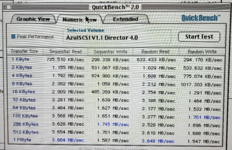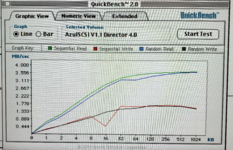rabbitholecomputing
Vendor The First
Update 2022-05-08: This product has been re-named ZuluSCSI
After months of development and extensive testing, It's finally time to pull back the curtains on our new SCSI emulation product, AzulSCSI. Brought to you by the ongoing global electronics component shortages, which have made it impossible to obtain the main microcontroller used in the SCSI2SD V5, the Cypress PSoC 5LP. While we still plan to manufacture SCSI2SD V5.2 and V5.5 in the future, parts availability makes it an impossibility at present.
TL;DR: Maximum read speeds with AzulSCSI V1.1 can be up to 3.9 megabytes/second, and maximum write speeds of ~2.1 megabytes/second are currently implemented. Improved write performance is in progress currently, and will be made available in the near future.
For those of you who are familiar with BlüeSCSI, you'll be right at home. Usage is very similar, but enhanced with SCSI-2 support, CD-ROM emulation support, and DIP-switch-controlled SCSI termination.
The AzulSCSI firmware looks for file names which adhere to a simple but powerful naming convention, and presents them as the drives to the SCSI host. Each image file represents a SCSI drive.
AzulSCSI is designed to power itself solely from SCSI termination power, with no separate power source needed, when the host device/computer provides SCSI termination power. Nearly all desktop Macintosh computers do.
AzulSCSI V1.1 includes an optional DB25 pin header for direct installation of an external SCSI connector, in addition to the Single-Ended 50 pin IDC connector. Savvy users may recognize that AzulSCSI V1.x looks very similar to the SCSI2SD V5.1 board layout, which we used as a starting-point. The AzulSCSI V1.1 shares the exact same dimensions and mounting holes as that of SCSI2SD V5.1, V5.2, and V6, and is therefore compatible with many existing SCSI2SD-V5.1, V5.2, and V6 mounting solutions.
Throughpout rates can be affected by particularly slow (eg. 8MHz 68000) CPUs. SCSI controllers can be, and often are, bottlenecks. Since AzulSCSI uses the same SCSI command handling code as SCSI2SD V6, compatibility with nearly all devices that speak both SCSI-1 and SCSI-2 is extremely high.
Termination is DIP-switch controlled, and firmware updates are as simple as placing a file on a FAT32 or exFAT-formatted SD card, inserting it in the SD card slot, and applying power to the AzulSCSI. A firmware recovery mechanism is also provided, as a back-up.
For more information about specific features, visit the AzulSCSI website at https://azulscsi.com
For those who enjoy tinkering, the firmware source is available at https://github.com/AzulSCSI/AzulSCSI-firmware. It can be built with PlatformIO, under Windows, Linux, and macOS. Patches and improvements are welcomed.
Here are some real-world AzulSCSI V1.1 performance benchmarks, captured on my Quadra 650:


After months of development and extensive testing, It's finally time to pull back the curtains on our new SCSI emulation product, AzulSCSI. Brought to you by the ongoing global electronics component shortages, which have made it impossible to obtain the main microcontroller used in the SCSI2SD V5, the Cypress PSoC 5LP. While we still plan to manufacture SCSI2SD V5.2 and V5.5 in the future, parts availability makes it an impossibility at present.
TL;DR: Maximum read speeds with AzulSCSI V1.1 can be up to 3.9 megabytes/second, and maximum write speeds of ~2.1 megabytes/second are currently implemented. Improved write performance is in progress currently, and will be made available in the near future.
For those of you who are familiar with BlüeSCSI, you'll be right at home. Usage is very similar, but enhanced with SCSI-2 support, CD-ROM emulation support, and DIP-switch-controlled SCSI termination.
The AzulSCSI firmware looks for file names which adhere to a simple but powerful naming convention, and presents them as the drives to the SCSI host. Each image file represents a SCSI drive.
AzulSCSI is designed to power itself solely from SCSI termination power, with no separate power source needed, when the host device/computer provides SCSI termination power. Nearly all desktop Macintosh computers do.
AzulSCSI V1.1 includes an optional DB25 pin header for direct installation of an external SCSI connector, in addition to the Single-Ended 50 pin IDC connector. Savvy users may recognize that AzulSCSI V1.x looks very similar to the SCSI2SD V5.1 board layout, which we used as a starting-point. The AzulSCSI V1.1 shares the exact same dimensions and mounting holes as that of SCSI2SD V5.1, V5.2, and V6, and is therefore compatible with many existing SCSI2SD-V5.1, V5.2, and V6 mounting solutions.
Throughpout rates can be affected by particularly slow (eg. 8MHz 68000) CPUs. SCSI controllers can be, and often are, bottlenecks. Since AzulSCSI uses the same SCSI command handling code as SCSI2SD V6, compatibility with nearly all devices that speak both SCSI-1 and SCSI-2 is extremely high.
Termination is DIP-switch controlled, and firmware updates are as simple as placing a file on a FAT32 or exFAT-formatted SD card, inserting it in the SD card slot, and applying power to the AzulSCSI. A firmware recovery mechanism is also provided, as a back-up.
For more information about specific features, visit the AzulSCSI website at https://azulscsi.com
For those who enjoy tinkering, the firmware source is available at https://github.com/AzulSCSI/AzulSCSI-firmware. It can be built with PlatformIO, under Windows, Linux, and macOS. Patches and improvements are welcomed.
Here are some real-world AzulSCSI V1.1 performance benchmarks, captured on my Quadra 650:


Attachments
Last edited by a moderator:

